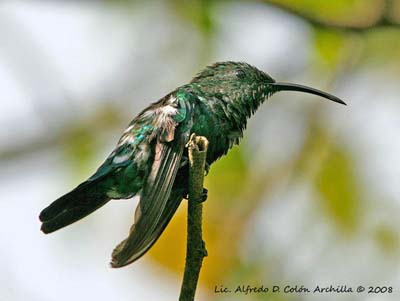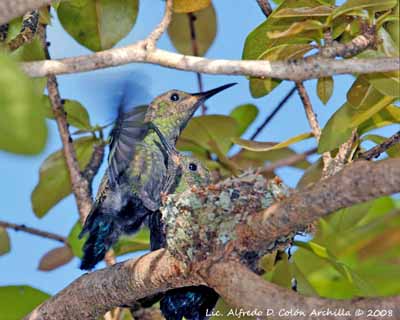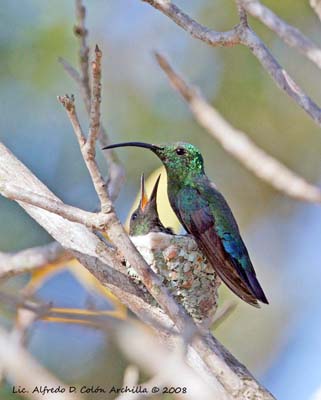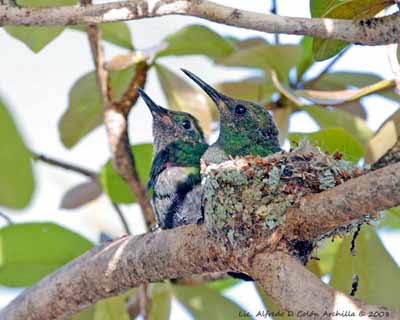
Green-throated Carib – Eulampis holosericeus
Apodiforme Order – Trochilidae Family
BIOMETRICS:
Length: 11-12,5 cm; Weight: M: 5,5-7,8 g – F: 5-5,5g
DESCRIPTION:
Green-throated Carib is a beautiful hummingbird which is resident in its range.
Adult male has metallic bronze-green upperparts. Uppertail coverts are mostly blue-green. On the wings, flight feathers are deep dark blue, as long as body.
On the underparts, chin and throat are metallic green, followed by bright blue crescent across the breast. Belly is black and undertail coverts are metallic blue. Rounded tail is dark blue. Flight feathers are greyish-brown and underwing coverts are green.
Head is metallic green. Black bill is slightly decurved. Eyes are dark brown. Legs and feet are dark grey to blackish.

BEHAVIOUR:
Green-throated Carib feeds on insects caught in the air. It also takes spiders from their webs. It feeds mainly on nectar of flowers, taken in low trees or shrubs, at about 1 to 4 metres above the ground.
Males often establish their feeding territories close to flowering tree or bush, in order to cover their daily energy needs.
Occasionally, male may defend strongly its feeding area, perching high near the food resource and giving warning calls. If an intruder enters, it is strongly attacked in flight. Birds grip with claws and can tumble to the ground. Usually, birds loose some feathers, but these fights are rarely harmful. Sometimes, food resources are too scattered to be defended, and birds cannot establish territory boundaries.
If a predator is detected by sight, it is directly approached by diving attacks. During this behaviour, high-pitched warning calls are given. Female performs flight attacks if the nest is threatened.
REPRODUCTION:
Green-throated Carib breeds from February to May, and female builds the nest on tree or bush periphery, at about 1 to 4 metres above the ground.
Nest is a compact cup which exterior is camouflaged by the use of pieces of bark and lichen. Interior is lined with soft materials, such as fibres of seeds, cacti and tree ferns.
Female lays two eggs. Incubation lasts about 17 to 19 days, only by female. She also feeds the flesh-coloured chicks which fledge about 20 to 22 days after hatching. Young remain for 3 to 4 weeks more with female.
This species usually produces one brood per year.
DIET:
Green-throated Carib feeds mainly on nectar of flowers. As almost all hummingbirds, it is mainly attracted by brightly coloured flowers. It may supplement this usual food with pollen caught while drinking nectar. It also consumes arthropods for proteins. Flies, wasps, ants, small beetles and spiders are also taken.
PROTECTION / THREATS / STATUS:
Green-throated Carib populations are not globally threatened. The range is restricted, but it is common resident, and these birds can be numerous in some parts of their habitat.
Local Puerto Rican name: Zumbador Pechiazul
Fr: Colibri falle-vert
All : Blaustern-Antillenkolibri
Sp : Colibrí Caribeño Gorgiverde
Ital : Colibrì dei Caraibi sericeo
Nd : Groenkeelkolibrie
Photographs :
Alfredo Colón
Puerto Rico Wildlife
Text by Nicole Bouglouan
Sources:
HANDBOOK OF THE BIRDS OF THE WORLD Vol 5 by Josep del Hoyo-Andrew Elliott-Jordi Sargatal - Lynx Edicions - ISBN: 8487334253

Both sexes are similar. Female has longer bill than male, and more decurved.
Juvenile resembles female, with washed brown head. It reaches its sexual maturity at 2 years.
We find two subspecies:
E.h. holosericeus, living in eastern Puerto Rico and Lesser Antilles except Grenada.
E.h. chlorolaemus, living in Grenada. This one has darker throat and broader blue crescent across the breast.
VOICE: SOUNDS BY XENO-CANTO
Green-throated Carib utters high-pitched chirps and whistles. Calls are given by both sexes from exposed perches and indicate abundant food resources kept by territorial birds.
Green-throated Carib defending its food area utters series of aggressive chattering while it chases rivals.
These sounds are specific and included in feature for identification in the wild.

HABITAT:
The resident Green-throated Carib lives in open secondary vegetation, semi-deciduous woodlands, rainforests, agricultural areas and parks. It can be found from sea level to 500 metres of elevation.
RANGE:
Green-throated Carib has limited range. It is found in Puerto Rico, Virgin Islands and Lesser Antilles where it is common resident.

Green-throated Carib male is polygamous and mates with several females. Nesting duties are carried out only by female, from nest building to feeding young.
Courtship displays often are similar to defence displays. Male utters songs, displays its iridescent plumage and performs some flight displays from dispersed perches, or at feeding area. It is visited by female when she is receptive for copulation.
Green-throated Carib is resident in its range, but some birds disperse from June to September to forest edges at 800 to 1000 metres of elevation.
FLIGHT:
Green-throated Carib performs hovering flights, used in feeding behaviour. The bird seems to be motionless in the air, but its wings move mainly in horizontal plane, in order to describe a kind of 8 with the wing tips. Using different wing angles, it can move forwards, sidewards and backwards, making also upside down movements.

